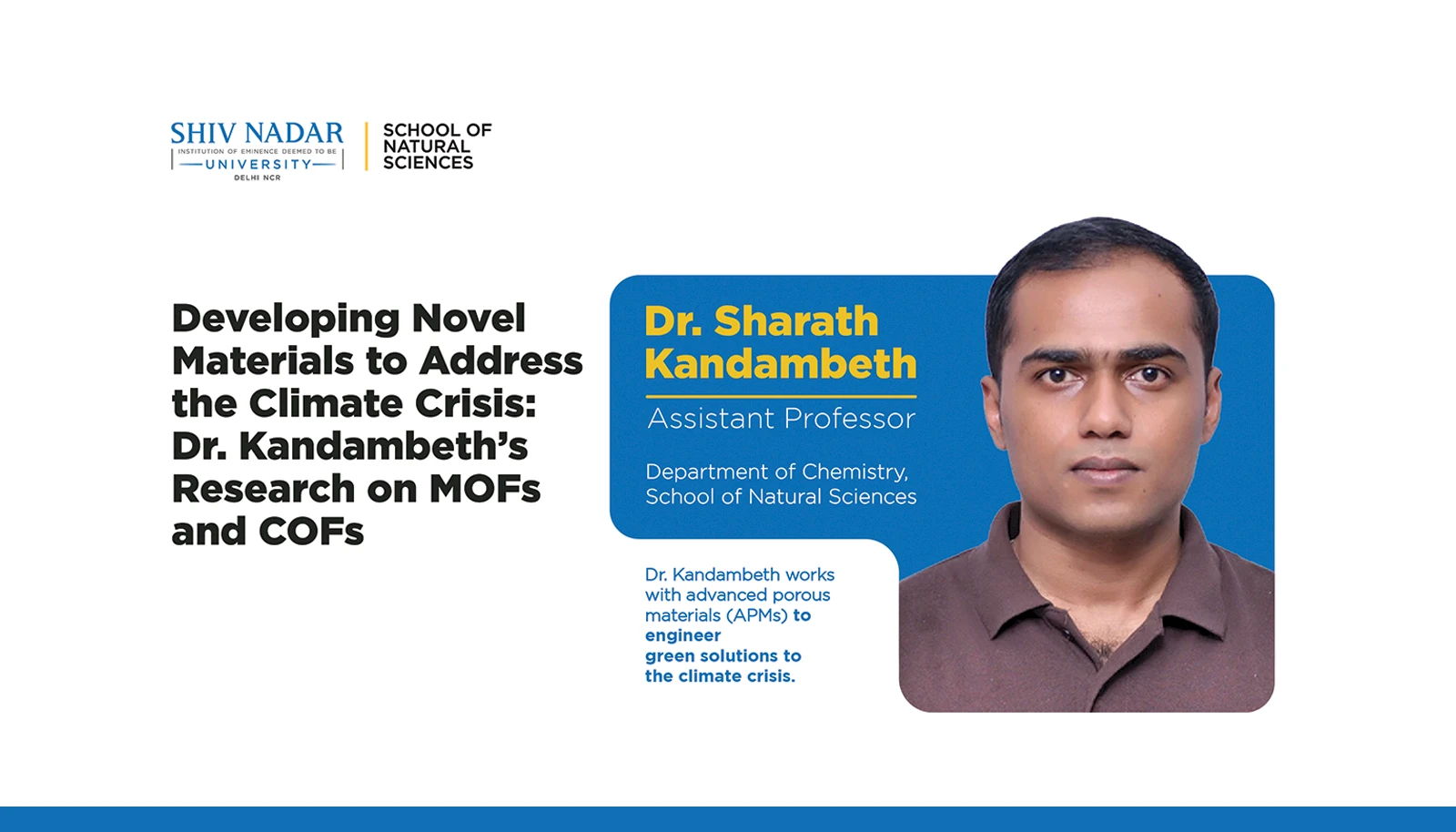Developing Novel Materials to Address the Climate Crisis: Dr. Kandambeth’s Research on MOFs and COFs

Editorial / August 01, 2025
In recent years, there has been growing emphasis on transitioning to green and renewable energy sources; this is the only way out of the climate crisis. But how do we make this transition more practical and economically feasible? The answer lies in engineering novel materials that can efficiently store energy, convert energy, and capture excess carbon dioxide.
Finding a solution to climate change is the driving force behind Dr. Sharath Kandambeth, Assistant Professor at the Department of Chemistry, School of Natural Sciences. Dr. Kandambeth works with two major classes of porous materials called metal–organic frameworks (MOFs) and covalent organic frameworks (COFs), both of which are highly promising for the capture and conversion of carbon dioxide.
MOFs are polymer materials that consist of metal clusters connected to one another through organic linkers, resulting in structures that have ultra-high porosities. COFs are similar to MOFs, except that instead of metals, they contain all organic substructures that are strongly linked through covalent bonds. These two classes of materials have a very wide range of applications, including catalysis, gas storage and separation, energy storage, molecular detection, and more. “The main advantage of these materials is that you can precisely tune the pore size, surface area, and functionalities, which means you can actually design their structure to fit your desired applications,” explains Dr. Kandambeth.
Most carbon capture technologies focus on removing carbon dioxide from industrial flue gases, before they can enter the atmosphere. But Dr. Kandambeth is focused on the greater challenge—direct capture of carbon dioxide from the atmosphere. The concentration of carbon dioxide compared to other gases in the atmosphere is very low, only around 0.0427%. This makes its direct capture very challenging; only highly selective materials that can bind carbon dioxide instead of the other 99% of gases in the atmosphere are useful for this application.
But these materials are not limited to only binding carbon dioxide. They also need to be able to desorb the captured carbon dioxide when needed or convert it into other useful chemicals. Most of the technologies to separate or convert captured carbon dioxide require high temperature or pressure. “We’re removing the carbon dioxide for a green purpose. So if we use high temperature and pressure, which requires the burning of further fuel, then it is not environmentally friendly after all,” points out Dr. Kandambeth. The COFs and MOFs designed for carbon capture need to be capable of fulfilling multiple needs. They need to be highly selective, highly stable, have a capacity for energy efficient desorption and conversion, and also enable highly selective conversion reactions (known as electrochemical reduction of carbon dioxide or CO2RR). Dr. Kandambeth’s research focuses on developing new materials that can meet all these needs. In particular, one of his research directions is the development of MOF/COF and nanoparticle composite systems that combine the capture and conversion of carbon dioxide into a single step, transforming captured carbon into valuable chemical products such as ethylene and ethanol through CO2RR.
Dr. Kandambeth also works on energy storage and conversion, another application that can help meet the goal of a sustainable future. MOFs and COFs can also be engineered specifically for energy-related applications, such as storage in batteries and super capacitors and energy generation from water splitting reactions.
One of the main challenges with electrochemical water splitting is that one half of the process, hydrogen evolution, is much more kinetically favourable than the other, oxygen evolution. Typically, porosity increases catalytic activity, but for a long time, this was not the case for MOFs. Dr. Kandambeth and his team researched the issue and discovered that the MOFs used for oxygen evolution were being decomposed by the harsh electrolytes used in the reaction, which diminished their porosity. In a recent breakthrough, his team developed a novel squarate-based MOF for oxygen evolution that shows high catalytic activity, porosity, and chemical robustness. Like the name suggests, squarate-based MOFs consist of an organic component with a distinct square shape.
Dr. Kandambeth’s work in catalytic conversion is not limited to electrocatalysis, he is also working on photocatalytic organic conversion reactions, with the same view of environmental responsibility and protection. His research into MOFs and COFs also includes the development of novel materials for nanofiltration of toxins from wastewater. “We need to start looking at everything through a green and sustainable lens,” he says. “That’s what makes MOFs and COFs so exciting—they have the potential to support a wide range of environmentally friendly applications.”
With the need for climate change mitigation and sustainability growing ever more urgent, we are excited to see the novel materials and applications Dr. Kandambeth puts forward next!
By Editage Digital Media Solutions, the research promotion division of Cactus Communications
Edited by- Srijita Banerjee
More Blogs

The Hawthornden Literary Retreat bestowed on Dr Sambudha Sen to complete the manuscript of a novel
Professor Sambudha Sen, Head of the Department of English at Shiv Nadar Institution of Eminence, Delhi-NCR, was awarded a residency at the...

The Power of the Moving Body
Movement is an innate bodily action that humans have been exhibiting for the longest time. Long before language was invented, the body was the...

How Does A Multi-Disciplinary Approach To Education Enhance Learning And Prepare Students For A Multi-Faceted World?
In today’s world, where businesses are changing almost every day, it is the responsibility of educational institutes to provide holistic...